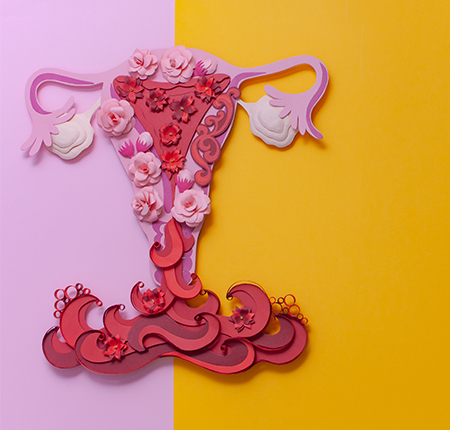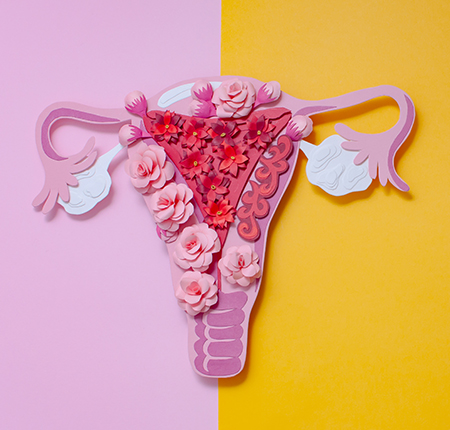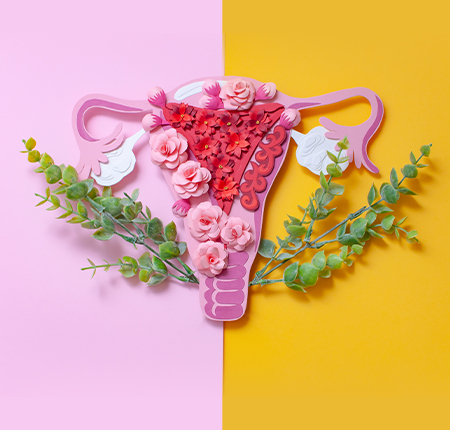
You've probably heard of it, but the volume of information - or even the lack of it - can be a challenge. What happens in the body of a person with endometriosis? Where does the condition come from and how can you treat it? These are just some of the questions we try to answer in this article.
What is endometriosis?
Common among women aged 25-35, endometriosis is the most common cause of chronic pelvic pain. Although it doesn't necessarily cause infertility, endometriosis affects fertility - that doesn't mean you can't get pregnant, just that it will be harder. As for the latest research, about half of women who suffer from infertility also suffer from endometriosis. But what is disease, exactly?
Endometriosis is a chronic condition in which the tissue that lines the uterus (endometrium) and similar tissue fragments are found outside the uterus.
The tissue fragments are also called "endometriosis lesions" and vary in size; they are found inside the abdominal cavity and can spread throughout a menstrual cycle.
The origin of endometriosis
The exact origin of endometriosis is not known. There are several theories about how endometriosis lesions appear, but there are still not enough studies. The good news is that scientific research is ongoing.
So what is known so far is that
The lesions may be related to the reflux of menstrual blood through the fallopian tubes
Endometriosis can also occur in women without a uterus, in teenage girls and in rare cases in men
There are several mechanisms that lead to the development of endometriosis lesions, not yet discovered.
Types of endometriosis
Although there is no relationship between the intensity of the pain and the type of endometriosis, doctors classify the condition into 4 types of endometriosis:
Superficial (or peritoneal)
Ovarian
Deep
Abdominal

Endometriosis symptoms
"Each month, endometriosis affects 1.5 million British women, but unfortunately many of them think it's just a painful symptom of their period." ( source )

As for the symptoms of endometriosis, the most common is pelvic pain during menstruation. Many people experience menstrual cramps, but those with endometriosis describe the pain as stronger than usual. Moreover, over time, the pain may worsen and may also manifest itself during sexual contact, which will be painful. When we say more severe pain, we also include bed rest and acute pain between periods.
Symptoms therefore include:
Dysmenorrhea - or painful periods - when pain and cramps are also accompanied by lower back and abdominal pain, and can extend before and after menstruation.
Pain during intercourse
Abdominal pain during urination and/or sitting on the toilet
Heavy bleeding and bleeding between periods
Infertility
Fatigue, diarrhea, nausea, diarrhea and other symptoms
What you need to know is that the degree of pain is not an indicator of the type of endometriosis or the extent of the condition - you can have superficial endometriosis with severe pain, for example.
Causes of Endometriosis
The exact causes of endometriosis are unfortunately unknown, but there are risk factors and there are some explanations that doctors can offer.
First, retrograde menstruation. What does this mean? Retrograde menstruation happens when menstrual blood backs up into the fallopian tubes instead of leaving the body - and the cells attach to the walls of the pelvic cavity, where they continue to grow
Then there is the "induction theory," where hormones promote the transformation of peritoneal cells into endometrial cells. Embryonic cells can also turn into endometrial cells during puberty.
Another cause would be surgical implantation - after an intervention (hysterectomy or caesarean section) the cells can attach to the incision.
Blood vessels can carry endometrial cells to other areas of the body.
Immune problems can cause the body not to recognize endometrial tissue outside the uterus.
How is Endometriosis prevented?
Precisely due to the fact that the causes of endometriosis are not exactly known and understood, the methods of prevention are also less known, but periodic annual check-ups are recommended from the first appearance of symptoms. Because early detection can help you reduce pain, discomfort and the risk of infertility.

Endometriosis risk factors
As with many conditions, there are various risk factors that can influence the onset of the disease. If:
You have hormonal imbalances, especially an increased level of estrogen
You never gave birth
There are members in your family who suffer from endometriosis
You have short menstrual cycles (less than 27 days)
Your menstrual bleeding is heavy and lasts more than 7 days
Menopause came at an advanced age
You have a low body mass index (BMI).
There are abnormalities of the reproductive system
These factors are not direct causes for the development of endometriosis, but they increase the risk, and in general, the disease can develop around the first period, after several years. Over time, symptoms may improve - especially during pregnancy, and may disappear with menopause.
The evolution of endometriosis
What you need to know is that endometriosis evolves, has several stages and the treatments to relieve the symptoms can be different. In the first phase, small foci appear in the body inside the affected organs. Then, foci of endometriosis multiply. The disease can evolve into deep foci or ovarian cysts, and in the last phase, there will be multiple foci, multiple large cysts and adhesions between the pelvic organs.
Endometriosis complications
As the disease progresses, there are more risks of health complications, especially difficulty getting pregnant, in addition to affecting other organs such as the bladder or intestines.
But the main complication is "impaired fertility", when fertility is deeply affected. Recent studies have shown that approximately more than one-third of women with endometriosis have this complication, and endometriosis remains one of the leading causes of infertility.
Endometrial cancer
As we said at the beginning of the article, endometriosis occurs when the tissue that lines the uterus, called the endometrium, begins to grow in other places. And you may be wondering, is there a link between endometriosis and endometrial cancer?
Well, the two conditions have some things in common (cell growth where it shouldn't, pelvic pain), and there is indeed evidence that endometriosis may slightly increase the risk of cancer, but there are also key differences.
Endometrial cancer occurs when endometrial cells have an abnormal appearance, grow uncontrollably and form a tumor. These cells can then spread to other parts of the body and become tumors.
But you must know: endometriosis is not cancer.
Although it has a higher incidence after menopause, endometrial cancer can also affect young women, and the incidence is over 95% in women over 40 years old. Endometrial cancer develops slowly, and undiagnosed and untreated can spread to other pelvic organs. The good part is that when it is detected in the early stage, it can be completely cured.
Endometriosis diagnosis
Only your gynecologist can accurately diagnose endometriosis, and the disease can be diagnosed from puberty to menopause, although it is not unusual for it to be detected 10 years after the first symptoms appear, and many women go through this.
Most of the time, the diagnosis is made easier in teenagers or young women, but it can also happen that the disease is detected by chance, during investigations or surgical interventions for other reasons. And in recent years, an endometriosis test has also appeared: this is an innovative blood test that can detect 90% of endometriosis cases from the first signs.
Endometriosis treatment
Being a chronic disease, endometriosis cannot be permanently treated, but it can be improved. The good thing is that there are treatment recommendations - drug, surgical or alternative - to help you relieve endometriosis pain and improve your quality of life.

However, the treatment depends on a number of factors such as the specific symptoms, the severity of the disease and the desire to get pregnant. Because all procedures and treatment recommendations may be aimed at relieving pain and/or achieving pregnancy.
Hormonal treatment
Among the recommended medical procedures is hormone therapy: the goal of hormone therapy is to reduce the estrogen produced by administering hormones for a limited period under close medical supervision. Other drugs that can help relieve pain are anti-inflammatories - for which you do not need a prescription (such as ibuprofen).
Contraceptive treatment has also been used for people with endometriosis for many years. How does it work? The birth control pill relieves endometriosis pain by suppressing menstruation and inhibiting the growth of endometrial implants.
Surgical treatment Endometriosis operation
Sometimes hormone therapies and anti-inflammatories don't work, and in this case laparoscopic surgery, a minimally invasive surgery that removes endometriosis cysts and treats infertility, may be recommended. But even after this treatment, the disease can recur.
Natural treatment
Unfortunately, endometriosis does not have a 100% cure, and very few affected people can say "I am cured of endometriosis". But treatments continue to develop and the natural one has advantages too. If you follow a naturopathic treatment, you will consider diet, herbal remedies, supplements and the practice of relaxation techniques.
Eating
It is important to include foods that reduce inflammation in the body as much as possible and exclude inflammatory foods such as red meat or carbohydrates.
plant
Or phytotherapy, it's a first treatment for endometriosis, because certain plants have a positive effect in regulating hormones and relieving pain. Among the recommended plants are raspberry shoots, mouse tail, cress, ginger, fennel, chamomile, or artichoke - you can consume them in the form of teas, as they are recommended for endometriosis
Supplements
Or introducing some superfoods into your diet to prevent oxidative stress and feed your body with antioxidants, vitamins and minerals such as vitamin B, C, magnesium or green tea.
easing
You can opt for yoga, breathing techniques and meditation - all will help you manage your symptoms better, and if necessary you can try reflexology or acupuncture.
Life with endometriosis
Because it's no surprise that chronic pain affects your everyday life. Life with endometriosis is challenging because the disease can make you feel depressed and angry, and it can affect your sleep.
That's why relaxation techniques help to manage pain but also to feel better mentally. Many patients are also prescribed antidepressants, psychotherapy sessions and meditation.
Recommended diet in endometriosis
As for the recommended diet, it is essential to have a balanced and healthy diet, and to practice regular sports. Certain foods are recommended, as we mentioned above, others should be avoided, although there are still not enough studies on this topic, but you can learn from the experience of those who struggle with endometriosis and find recommendations.
For example, it is recommended to avoid the consumption of trans fats, red meat, products containing gluten - if you notice that a gluten-free diet helps to relieve pain. Instead, the consumption of Omega-3, as many vegetables, greens, fruits, seeds, proteins and vegetable fats as possible are recommended.
To conclude our article, if when you're on your period it's more of a curse than a blessing , don't hesitate to schedule a specialist consultation! Annual check-up with the appearance of symptoms is our advice!






















